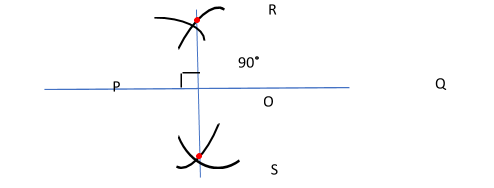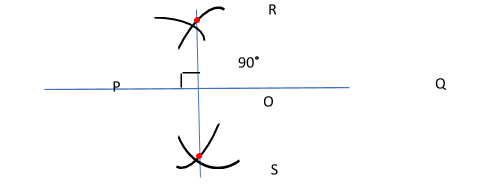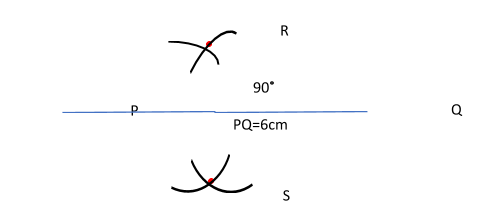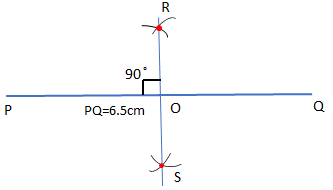
Draw a line segment $\overline {PQ} $ of length \[6.5cm\]. Construct the perpendicular bisector of $\overline {PQ} $ using a ruler and compasses. Write the steps of construction.
Answer
573.9k+ views
Hint: If a line cuts a line segment in equal parts vertically at ${90^ \circ }$, then that vertical line is called perpendicular bisector of line segment as shown in figure below:

To construct a perpendicular bisector, first draw a line segment PQ with the help of a ruler. Taking P and Q as centre with the same radius cut off arcs on both sides i.e. above and below the line segment with the help of a compass. Then join the points R and S as shown in above figure.
Complete step-by-step answer:
With the help of a ruler draw a line segment PQ, say\[PQ = 6cm\].

Taking P as centre and radius more than half PQ and mark an arc with the help of compass on both sides i.e. above and below the line segment PQ.

Taking Q as centre and the same radius and mark an arc with the help of compass on both sides i.e. above and below the line segment PQ.

Taking Q as centre and the same radius and mark an arc with the help of compass on both sides i.e. above and below the line segment PQ.

Join PQ, cutting PQ at O. Then O bisects RS.

We have successfully constructed the perpendicular bisector of PQ i.e. RS.
You can also check if the measure of \[PO = OQ = 3.25cm\] & $\angle POR = \angle QOR = {90^ \circ }$. If it satisfies these parameters then the construction is accurate.
Therefore, RS is the perpendicular bisector of PQ.
Note:1. You can draw a rough sketch of the construction so you can get the clear idea of the construction.
2.Don’t change the radius while making the arc from both sides.
3.While measuring the angle starts from zero degrees.
4.Try to measure with greater accuracy.

To construct a perpendicular bisector, first draw a line segment PQ with the help of a ruler. Taking P and Q as centre with the same radius cut off arcs on both sides i.e. above and below the line segment with the help of a compass. Then join the points R and S as shown in above figure.
Complete step-by-step answer:
With the help of a ruler draw a line segment PQ, say\[PQ = 6cm\].

Taking P as centre and radius more than half PQ and mark an arc with the help of compass on both sides i.e. above and below the line segment PQ.

Taking Q as centre and the same radius and mark an arc with the help of compass on both sides i.e. above and below the line segment PQ.

Taking Q as centre and the same radius and mark an arc with the help of compass on both sides i.e. above and below the line segment PQ.

Join PQ, cutting PQ at O. Then O bisects RS.

We have successfully constructed the perpendicular bisector of PQ i.e. RS.
You can also check if the measure of \[PO = OQ = 3.25cm\] & $\angle POR = \angle QOR = {90^ \circ }$. If it satisfies these parameters then the construction is accurate.
Therefore, RS is the perpendicular bisector of PQ.
Note:1. You can draw a rough sketch of the construction so you can get the clear idea of the construction.
2.Don’t change the radius while making the arc from both sides.
3.While measuring the angle starts from zero degrees.
4.Try to measure with greater accuracy.
Recently Updated Pages
You are awaiting your class 10th results Meanwhile class 7 english CBSE

Master Class 7 Social Science: Engaging Questions & Answers for Success

Master Class 7 Science: Engaging Questions & Answers for Success

Class 7 Question and Answer - Your Ultimate Solutions Guide

Master Class 7 English: Engaging Questions & Answers for Success

Master Class 7 Maths: Engaging Questions & Answers for Success

Trending doubts
Full Form of IASDMIPSIFSIRSPOLICE class 7 social science CBSE

Convert 200 Million dollars in rupees class 7 maths CBSE

i What trees does Mr Wonka mention Which tree does class 7 english CBSE

What are the controls affecting the climate of Ind class 7 social science CBSE

Write a letter to the editor of the national daily class 7 english CBSE

Welcome speech for Christmas day celebration class 7 english CBSE





